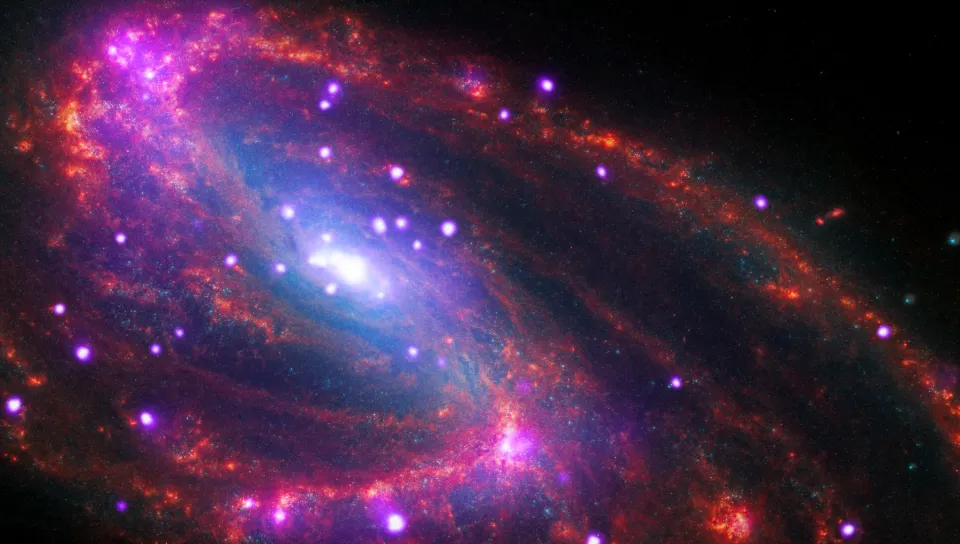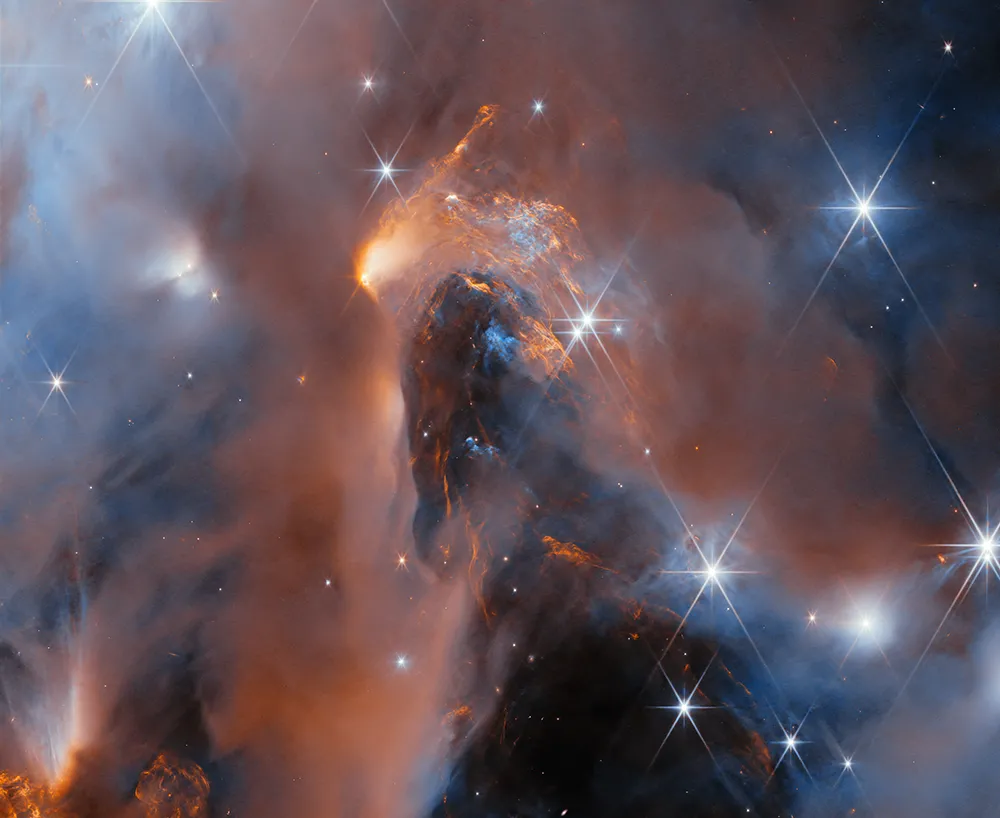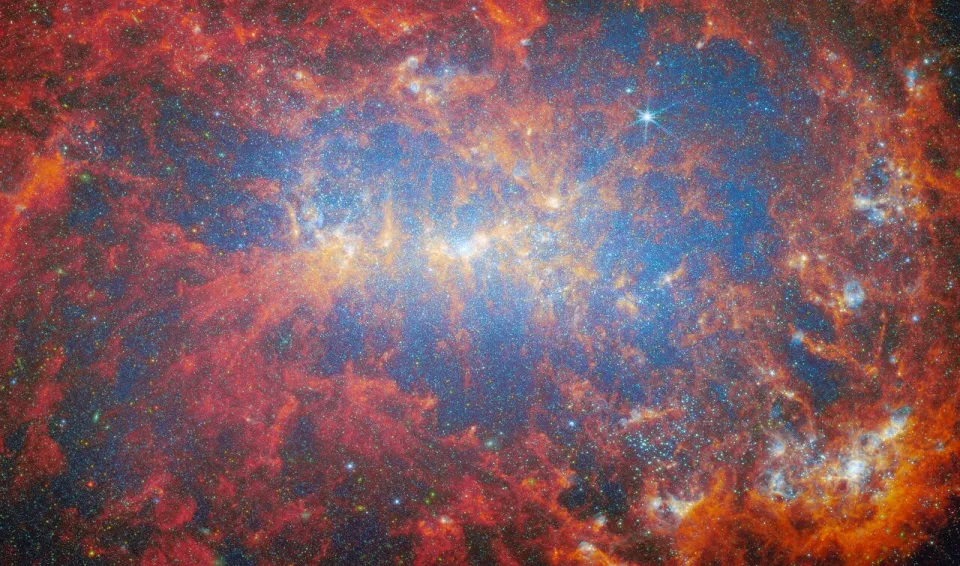A New Lens on the Cosmos
Smith Quarterly
The immense promise of the James Webb Space Telescope
JWST captured this stunning image of the closest star-forming region to Earth, the Rho Ophiuchi cloud complex. Credit: NASA, ESA, CSA, STScI, Klaus Pontoppidan (STScI)
Published October 10, 2024
Astronomy professor James Lowenthal says looking at images from NASA’s James Webb Space Telescope (JWST) is “like seeing baby pictures” of the universe. Kimberly Ward-Duong, an assistant professor of astronomy, calls it “the Swiss Army knife of telescopes” for its versatility and the stunning clarity of its images. For physics professor Gary Felder, JWST’s infrared capabilities could unlock “huge mysteries” about the formation of the first stars. For these Smith faculty members, JWST holds immense promise for advancing our understanding of the cosmos and reshaping how we view our place in the universe.
Ward-Duong is a member of one of the Early Release Science teams that obtained datasets from the telescope soon after it launched in 2021. She says having JWST in space “opens up all of this new science that we aren’t able to do from the ground, even with the biggest telescopes. It’s like making science fiction reality.” Her students are now learning how to interpret data produced by JWST—with more to come.
Here’s what these experts have to say about the impact of NASA’s newest space telescope.
How is this telescope different from all other telescopes?
James Lowenthal: Bigger, better, infrared-er! Most cutting-edge astronomy is studying really faint things—low-mass stars or exoplanets or distant galaxies. JWST is just a bigger light bucket, and that means sharper vision and clearer pictures.
Gary Felder: JWST is also better than most telescopes because it’s in space. One of the most challenging things for astronomy is Earth’s atmosphere, which makes it hard to see [into space] because we’re looking through miles and miles of turbulent air. Having cameras in space is huge. Then there’s the comparison point to Hubble [a space telescope launched in 1990]. JWST is more than 10 times bigger in area, and it’s infrared. Infrared light can go through a lot of gas and dust, and the light stretches out as the universe expands. A lot of the very old light from the first stars and galaxies that was visible light when it was emitted is now infrared. JWST can see some of that very old material better than Hubble can.
This is a composite image of galaxy NGC 3627 from NASA’s Chandra X-ray Observatory, the Hubble Space Telescope, and the James Webb Space Telescope.
Credit: X-ray: NASA/CXC/SAO; Optical: NASA/ESO/STScI, ESO/WFI; Infrared: NASA/ESA/CSA/STScI/JWST; Image Processing: NASA/CXC/SAO/J. Major
What are scientists looking for with the telescope?
Kimberly Ward-Duong: A huge mission goal for JWST and NASA in general is about cosmic origins. They can be the origins of the earliest galaxies, or of where planets and stars form. They can even be about the cosmic death of stars and the life cycle that allows stars to recycle their material to create new generations of galaxies and stars.
Some of the key science that JWST has enabled in areas I work on has been to study regions of thick gas and dust where there are stellar nurseries. What are the ingredients, the building blocks, that allowed these new stars and planets to form? JWST allows us to not only search for those new planets but also to discover solar systems beyond our own. And with sharper resolution, it’s also opened up amazing science about things closer to home. We’ve been able to see the rings of dust around Jupiter in striking detail and color, and plumes of water jets coming from tiny moons like [Saturn’s] Enceladus.
JL: We can see galaxies we couldn’t see before. One of the surprises that jumped out of the first deep galaxy pictures looking far back in time and space was that there seemed to be more than expected massive, fully formed galaxies that had evidently made stars earlier than we thought possible.
GF: We don’t really understand in detail how stars formed when there was nothing in the universe but hydrogen and helium to form them out of. We have some ideas about it, some models, but there’s a lot we don’t understand there. I’m really hoping to learn about that.
Who owns the data collected by the telescope?
KWD: A beautiful thing is that the data actually belongs to everyone. A lot of the initial data, the first images that were taken, were part of the Early Release Science effort. Before the telescope launched, huge teams of people from all over the world came together to write proposals to say, This is some of the most important, exciting early science that we should do with this telescope. As soon as JWST launched, it got to its destination in space, turned everything on, tested its instruments, and then the first data immediately became available to the whole world.
JWST‘s sharp infrared vision lets us peer through the dusty veil to reveal newborn stars.
Credit: ESA/Webb, NASA & CSA, A. Scholz, K. Muzic, A. Langeveld, R. Jayawardhana
What about access to research time?
KWD: JWST is now the most highly sought-after telescope in all of history and has the most proposals submitted on a yearly basis. I think there are something like 2,000 research proposals from all over the world. Those proposals get read and evaluated by teams of volunteer astronomers; from those, you have a less than one in 10 chance of actually getting time to use the telescope. Once teams are awarded time in this competitive process, they’re usually given about a year to have the data they gathered just for themselves so they can look at it carefully—and then it becomes public.
GF: That’s another huge advantage to the telescope being in space. In astronomy, you can put in these proposals far in advance for a little segment of time with a [ground] telescope, and then you wait six months and it’s cloudy that night. You just don’t have to worry about that in space.
JL: You can worry about other things.
Like what?
JL: Like, is the telescope going to work? If it breaks at all, nobody can ever fix it. That’s another difference between Hubble and JWST. Hubble is in low Earth orbit, and it’s been repaired numerous times by astronauts and boosted as its orbit decays. JWST is a million miles away, and if anything goes wrong, it’s forever.
GF: To be clear, he’s being literal. A million miles.
KWD: Yes, literally a million miles away!
“JWST allows us to not only search for new planets but also discover solar systems beyond our own.”
There has been some controversy about the name of the telescope.
GF: In the 1960s, NASA was headed by James Webb, and he is considered by many to be one of the people responsible for making the Apollo missions happen. NASA decided to name the telescope after him. But the ’60s was also the time of what has come to be known as the Lavender Scare, when many real or suspected homosexuals were forced out of government jobs. It’s unambiguous that people were forced out of jobs at NASA as part of the scare. There has been debate about the extent of Webb’s role in that. Because of that, there are many astronomy publications that won’t use the name Webb. They refer to it as JWST—and you may have noticed, that’s how we’ve been referring to it as well.
I would add that NASA’s next planned Great Observatory already has a name, which I have never heard any controversy about. The Hubble telescope was brought to fruition over the course of several decades largely under the stewardship of NASA’s first-ever chief astronomer, Nancy Roman. The next Great Observatory is scheduled to be named after Roman.
What are you hoping to learn from JWST?
JL: The Milky Way, the solar system, our planets, and the sun are about 4.5 billion years old. Globular clusters are the oldest parts of the Milky Way, the oldest stars. JWST stands to provide the best evidence to actually see those globular clusters forming in distant galaxies in the early universe. It’s a piece of the puzzle of how the Milky Way got to be the way it is, how every other galaxy got to be the way it is, how the diversity of the galaxy is explained.
KWD: There’s a fundamental question of uniqueness. We live on this planet; is Earth unique? Is the sun unique? We know there are other sun-like stars in the Milky Way, but do they have solar systems like ours, or are we an unusual outcome of the star formation process? Are Earth-like planets commonplace? We don’t know the answers yet. Understanding how a galaxy is formed might not change your day-to-day life, but it might change how you see yourself in the universe.
JWST‘s look at “starburst” galaxy NGC 4449, located 12.5 million light years away.
Credit: ESA/Webb, NASA & CSA, A. Adamo (Stockholm University) and the FEAST JWST team
How do you think about our place in the universe given the climate crisis on our planet?
JL: We astronomers speak the same scientific language as climate scientists. We know there is no planet B, that we can’t escape our problems by moving to Mars. Astronauts who have been in space all have this profound sense of the fragility of the Earth. For myself, I just love looking with my eyes at the night sky and thinking, Oh, that’s the Milky Way. We’re in this disc, and this path of light across the sky is like all the blueberries in the blueberry pancake lined up together. I just like to understand that—all of these questions we’re discussing are extensions of that wanting to know.
GF: There’s no tension between that curiosity about the universe and the urgency of solving our problems here at home. Working on cosmology, as I do, and trying to understand the origins of the universe, there are absolutely potential practical benefits. Every time we’ve had advances in our fundamental understanding of the laws of nature, it has led to practical outcomes. But my real motivation is curiosity. To me, one of the truly beautiful things about our species is that we are innately curious and we choose to put time and energy into understanding the nature of the universe and our place in it.
KWD: I agree wholeheartedly with James and Gary. I think we’re in a really exciting era for astronomy. We have JWST now, and we have the Nancy Grace Roman Telescope on the horizon. We’re also entering an era of extremely large telescopes on Earth. What astronomy has to offer is something akin to the experience of being out in nature, the experience of seeing the grandeur of the cosmos. It gives you a more profound appreciation for preserving the beauty of what we live with and the planet we live on.



